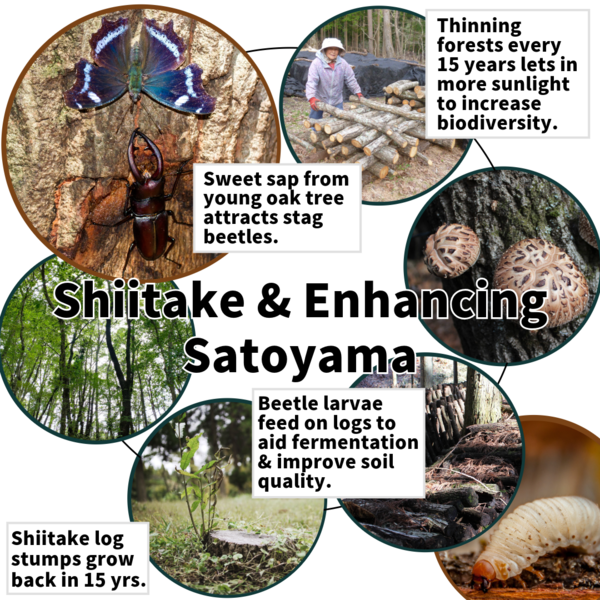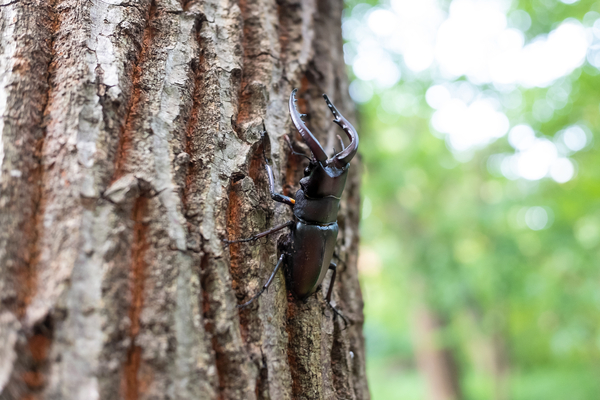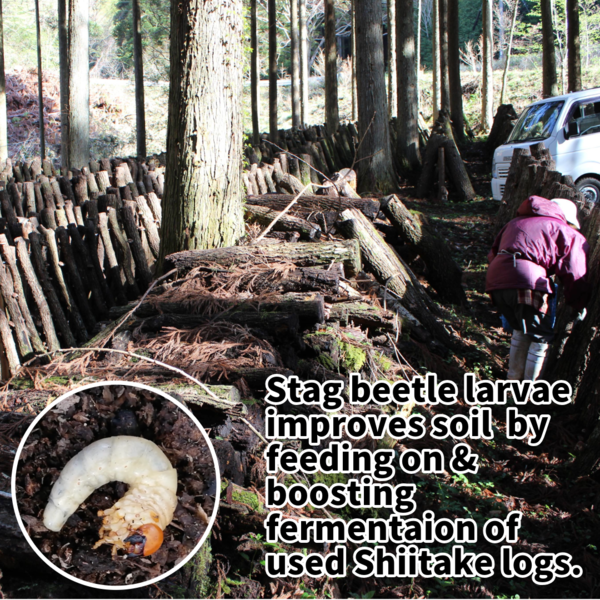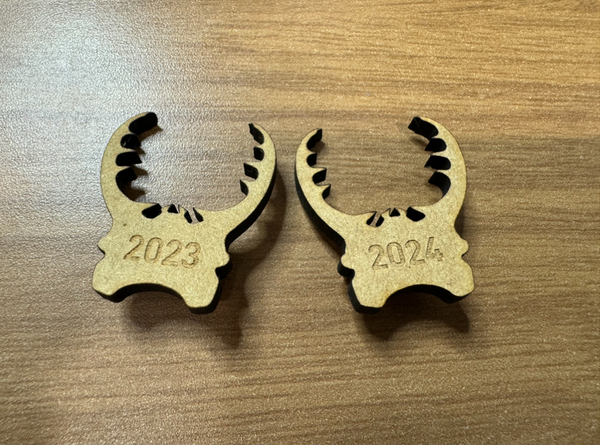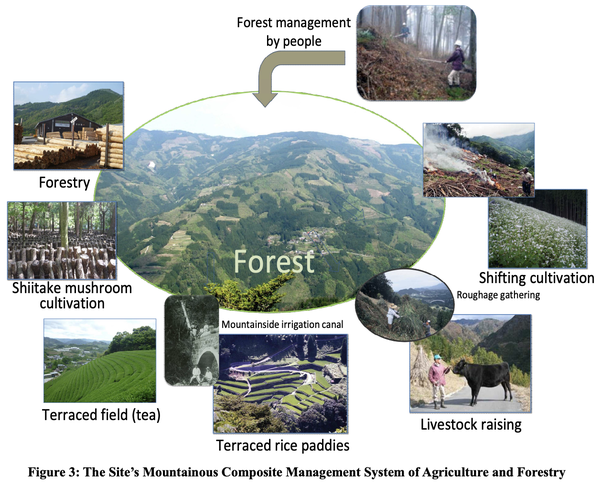The splendid biodiversity created by shiitake mushroom spores, sawtooth oak, humans & stag beetles strengthens Satoyama.
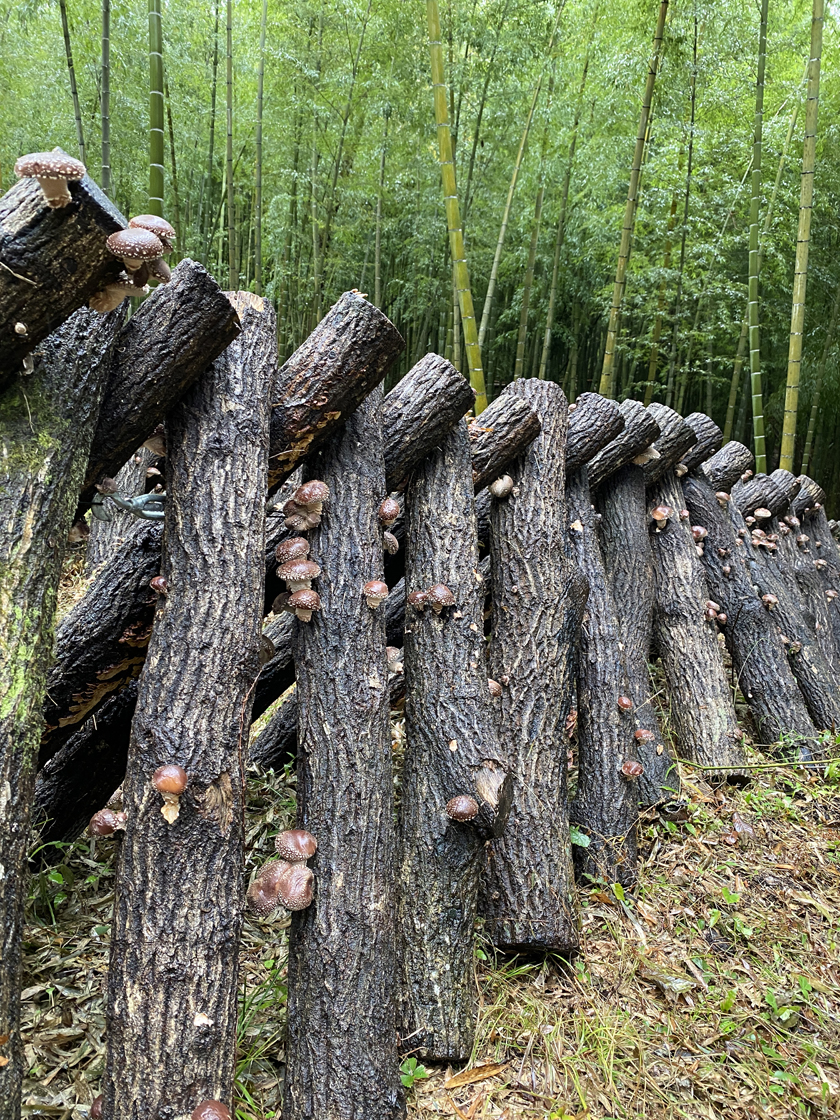
Tag: #Satoyama #SatoyamaCulture #ForestRegeneration #SustainableForestry
Table of Contents
Reviving Satoyama, living in harmony with nature.
How does 1,000 years of shiitake cultivation promote a Satoyama culture?
|
Satoyama refers to traditional Japanese rural landscapes where forests, rice paddies, and human communities coexist in harmony. It is a model of sustainable land use where people manage natural resources such as wood, water, and agricultural products while maintaining biodiversity. Satoyama environmental landscapes are defined by the harmony between nature and human activity, resulting in a rich ecosystem that sustains wildlife, agriculture, and other activities. |
In our shiitake cultivation, shiitake spores, sawtooth oak forests, humans, and stag beetles work together to create a Satoyama landscape where nature greatly increases biodiversity. Below is an overview of how Satoyama is achieved.
Shiitake spore: produces tasty and healthy shiitake mushrooms on Kunugi (Sawtooth Oak) logs, which require thinning forests and create the initial Satoyama effect.
Kunugi (sawtooth oak): after cutting into logs, the remaining stump will sprout and grow naturally. The tree will regrow and mature in about 15 years after it is cut down. Young growing sawtooth oak absorbs more CO2 than old trees.
Humans: provide the labor and receive economic value by thinning trees to support Satoyama biodiversity. Thinning gets more and better undergrowth, contributes to biodiversity, improves the water retention capacity of mountains, and reduces flood disasters.
Stag beetles: The larvae are very fond of old, no longer usable shiitake logs. They chew through old logs, fermenting them to return them as rich soil, playing a crucial role in forest regeneration. Many Japanese children are fascinated with keeping adult stag beetles as pets.
How Satoyama is supported is explained in more detail below.
Kunugi sprouts naturally from stumps and the forest will regenerate in 15 years.
The 1,000-year-old Japanese tradition of growing natural Shiitake contains wisdom that may be obscure to modern mass agricultural techniques. The video records the knowledge and experience of a master local Shiitake farmer who can remember at least three generations of Shiitake cultivation. He will reveal how traditional approaches are often better for our environment and produce a better quality Shiitake.
In this video, a shiitake master explains how a sawtooth oak cut down for shiitake cultivation naturally regenerates repeatedly from the stump. See how he increases the probability of faster and stronger growth from stumps while improving the condition of the surrounding forest.
Shiitake cultivation takes forests from sustainability to regeneration.
Secrets of thinning: shiitake cultivation helps the forest
Some people have the misconception that cutting trees is bad. Clear-Cutting is definitely not good for the global environment, but thinning is very important for maintaining a sustainable and strong Satoyama synergy. This section explains the difference between clear-cutting and thinning from the perspective of Satoyama.
Clear-cutting: Bad.
Clear-cutting is a method whereby an entire large area of forest is cut down at one time. The main characteristics are as follows
Purpose: it is mainly used for the purpose of providing a large supply of timber quickly or for conversion to non-forest uses.
Impact: after clear-cutting, large areas are left bare and vegetation is completely lost. This can lead to environmental problems such as soil run-off and water quality degradation. There is also a temporary collapse of the ecosystem and a temporary loss of many plant and animal species.
Recovery: after clear-cutting, new plantings and natural regeneration are required and it takes a long time for the ecosystem to return to its original richness.
Thinning: good
Thinning is a method of thinning a selection of trees in a forest to promote the growth of the remaining trees. The main characteristics are as follows:
Purpose: This is done to maintain forest health and promote growth. This allows light and wind to reach further into the forest and promotes the growth of undergrowth and shrubs.
Impact: thinning maintains the overall structure of the forest and only part of the forest is cleared. This allows more sunlight into the forest and the expectation of growth of undergrowth and shrubs; more young trees that absorb more CO2 are produced; and the forest is more productive, with more and healthier trees growing
Recovery: the remaining trees will grow healthier, increasing the biodiversity of the forest as a whole. Repeated periodic thinning maintains a sustainable self improved Satoyama.
3 steps to shiitake cultivation regenerating forests.
Step 1: Dark and overcrowded forest conditions
Due to overcrowding of trees, the interior of the forest is very dark and little light reaches the ground. This makes it difficult for undergrowth and shrubs to grow, resulting in low biodiversity.
Step 2: Thinning and ensuring light
Cutting down selected trees to increase spacing and allow light to reach the forest floor. This will allow more undergrowth and shrubs to grow and improve ventilation. Periodic thinning allows for additional light to enter the ground area and enables more varieties of plants to flourish.
Step 3: Creating a healthy & sustainable Satoyama
Regular thinning and continued maintenance of woodlands will allow a diverse range of plants to grow and the number of animals that feed on them to increase. As a result, biodiversity increases and a robust satoyama is formed where people can live in harmony with nature while carrying out agriculture and forestry.
Conclusion.
Forest-grown Shiitake manages the density of the forest through thinning, thereby rejuvenating sun deprived and overcrowded forests into resilient Satoyama results with a healthy and diverse ecosystem. This process is an important activity for humans and nature to live together and is at the heart of Satoyama culture.
We won the grand prize of the Sustainable Award 2020 from the Japanese Government.
Forests absorb more CO2 via shiitake cultivation.
Older forests grow slower and absorb less CO2. Therefore, by thinning forests and cutting down older trees, and allowing younger trees to grow, the forest's CO2 absorption capacity can be increased. The Forestry and Forest Products Research Institute's 'Average amount of carbon absorbed (fixed) by forest trees (trunks, branches, leaves and roots) ' is a cumulative figure, so the carbon absorption for each age class of broadleaved natural forest can be calculated as follows.
| Age of a tree | 1-5 | 6-10 | 11-15 | 16-20 | 21-25 |
| Lumber volume(m3/ha) | 4 | 28 | 40 | 53 | 68 |
| Carbon Stock(t/ha) | 2 | 13 | 6 | 7 | 4 |
Note: 6–10 year-old trees absorb the most CO2 = 13 metric tons per hectare of land.
Shiitake cultivation increases the water retention capacity of forests
The relationship between water retention capacity of forests and thinning
Role of water retention capacity of forests:
The soil in forests is like a sponge with many small crevices, which can temporarily store rainwater. This function ensures that rainfall does not immediately run off into rivers, but gradually percolates into the ground and flows steadily out into rivers. This contributes to flood mitigation and water purification.
What is thinning? (Forestry Agency) in Japanese
https://www.rinya.maff.go.jp/j/kanbatu/suisin/kanbatu.html
What about forests that nurture water (Forestry Agency) in Japanese
https://www.rinya.maff.go.jp/j/suigen/suigen/con_1.html
What thinning can bring
Thinning provides the following benefits
Light: Thinning allows light to penetrate into the forest, allowing the understorey vegetation to grow in abundance. The understorey vegetation effectively absorbs rainwater and improves the soil's water-holding capacity.
Soil stabilization: Healthy understorey vegetation stabilizes the soil and prevents soil run-off. This improves the forest's water recharge function and reduces the amount of water run-off during floods.
Root development: the remaining trees have deeper roots and absorb soil moisture more effectively. Deeply spread roots hold the soil in place and further improve water retention.
Specific benefits of thinning
Rainwater storage: Rainwater that percolates into forest soil is stored in the soil and slowly runs off into rivers. This delays flood peaks and stabilises flows.
Water purification: rainwater that passes through forest soils is purified by being absorbed by plants and reacting with minerals in the soil. This results in clean, moderately mineralized water that flows out into rivers.
Conclusion.
Thinning is an important means of maintaining forest health and improving water retention. Proper thinning allows the understorey vegetation to grow in abundance, improving the soil's water-holding capacity and contributing significantly to flood mitigation and water purification. This ensures sustainable forest management and promotes a stable supply of local water resources.
Video: Water is flowing out of Shiitake Mountain into the river even on the third day after the typhoon passed (Video taken 21 Sep 2022).
Typhoon No. 14 (NANMADOL) made landfall near Kagoshima City in 2022 at around 19:00 on 18 September with very strong force, traversed Kyushu through the morning of 19 September and changed to an extratropical cyclone east of Japan at 09:00 on 20 September, resulting in record heavy rain and storms in western Japan, especially Miyazaki Prefecture. As shown in this video, the mountains catch the heavy rainfall once and channel it into the river over a period of three days, which can greatly alleviate flooding downstream.
The proper thinning of forests in conjunction with Forest-grown Shiitake mushrooms creates a rainwater storage effect.
Rainwater that percolates into the forest soil is stored in the soil and slowly flows out into the river. This delays flood peaks and stabilises flows.
Supporting ecosystems: shiitake spores and stag beetles.
The sweet sap of the sawtooth oak used to grow shiitake mushrooms is famous for attracting stag beetles.
Adult stag beetles are attracted to young sawtooth oak trees with a large amount of sap, so if the forest is not thinned and regenerated into a young forest through shiitake mushroom cultivation, they will move out in search of young forests.
Also, without thinning, the forest becomes darker and undergrowth and shrubs do not grow, so other insects disappear.
Some people may think that insects are unnecessary in our modern, comfortable lives, but they play a very important role for the planet. For example, stag beetle larvae love the decaying forest-grown Shiitake logs that have finished their role in Shiitake cultivation, feeding on and adding enzymes to speed up fermentation and improve soil quality. Larvae tunnel into decaying wood, increasing the surface and air space of the wood, which further facilitates its decomposition by other filamentous fungi and bacteria in the additional areas created by the larvae.
Stag beetle larvae work with humans in Shiitake farms, as shown in the following picture.
|
Stag beetles play an important role in breaking down dead wood in forests. The larvae of these beetles eat many types of fungi that grow on rotting logs. Female stag beetles also have a special organ in their bodies that stores microbes. These stag beetles carry and spread yeast that ferments sugars in the wood when they lay their eggs. Because of this, stag beetles help break down dead wood both physically (by eating) and chemically (with the help of fungi). Adult stag beetles also play a key role with a substance called "slime flux," which is the sweet sap that oozes out from the bark of trees. These beetles carry bacteria and fungi that live in this sap, and they help ferment it. This process creates food for other insects. |
From: "Diversity of Stag Beetle-Associated Nematodes in Japan"
In "Silent Earth: Averting the Insect Apocalypse," the importance of insects is explained as follows:
| The American biologist Paul Ehrlich famously likened loss of species from an ecological community to randomly popping out rivets from the wing of an aero-plane. Remove one or two and the plane will probably be fine. Remove ten, or twenty, or fifty, and at some point that we are entirely unable to predict, there will be a catastrophic failure, and the plane will fall from the sky. Insects are the rivets that keep ecosystems functioning. How close we are to the edge is unclear. In a few places we've already gone over. |
Forest-grown Shiitake mushrooms promote Satoyama in repetitive cycles of about 15 years. Young sawtooth oak not only absorbs more CO2, but also attracts insects with its abundant sweet sap due to the growth process, creating a rich ecosystem.
SUGIMOTO SHIITAKE has been a member of the Kuwagata Summit ( Insect Sanctuary Council) since 2023. We will actively contribute to the presentation of a rich satoyama culture. (Kwagata means stag beetle in Japanese.)
Takachiho-go is one of the Globally Important Agricultural Heritage Systems (GIAHS).
Takachiho-go has been selected as a GIAHS! See the beautiful Satoyama scenery, which is more than just shiitake mushrooms.
Picture from: GIAHS Application Form
https://takachihogo-shiibayama-giahs.com/wp-content/themes/original/pdf/World-Agricultural-heritage-instructions-English.pdf
Historic Japanese Satoyama and Shiitake
Please also check out the following blog. The satoyama culture in Japan began in the Jomon period and reached its peak around 1930, but the satoyama culture is still alive and well in Takachiho-go and is listed on the Globally Important Agricultural Heritage Systems (GIAHS).
Shiitake's Great Journey: Harvard's DNA Analysis

